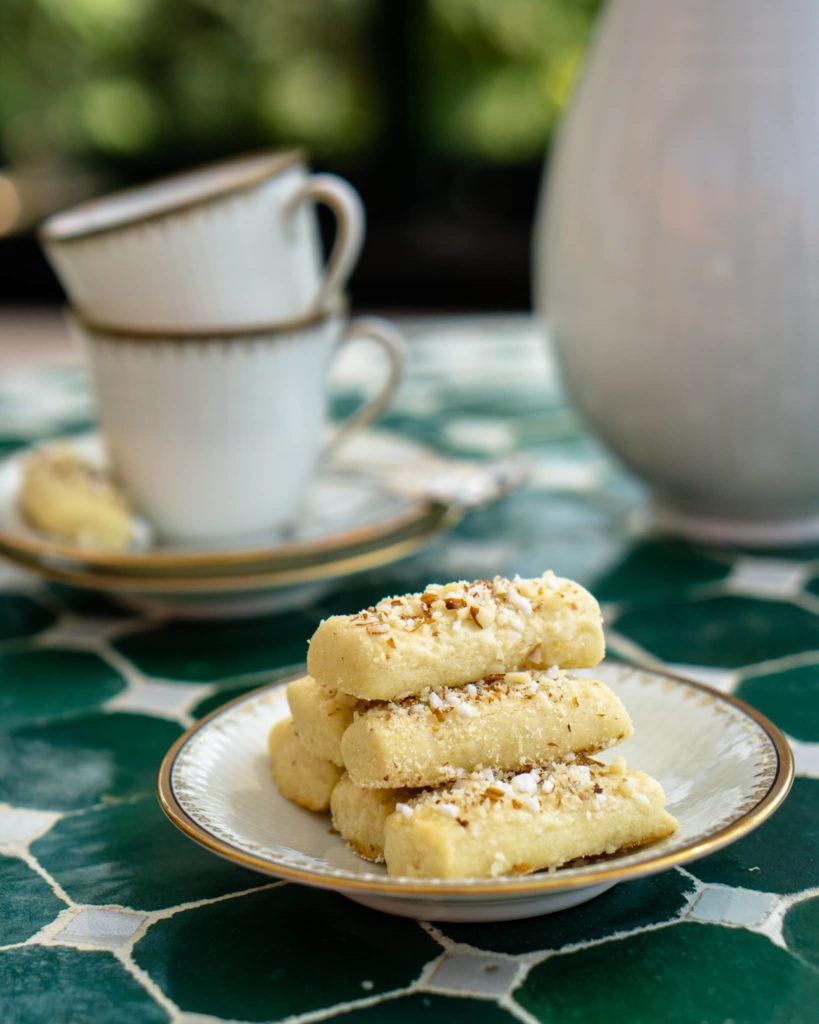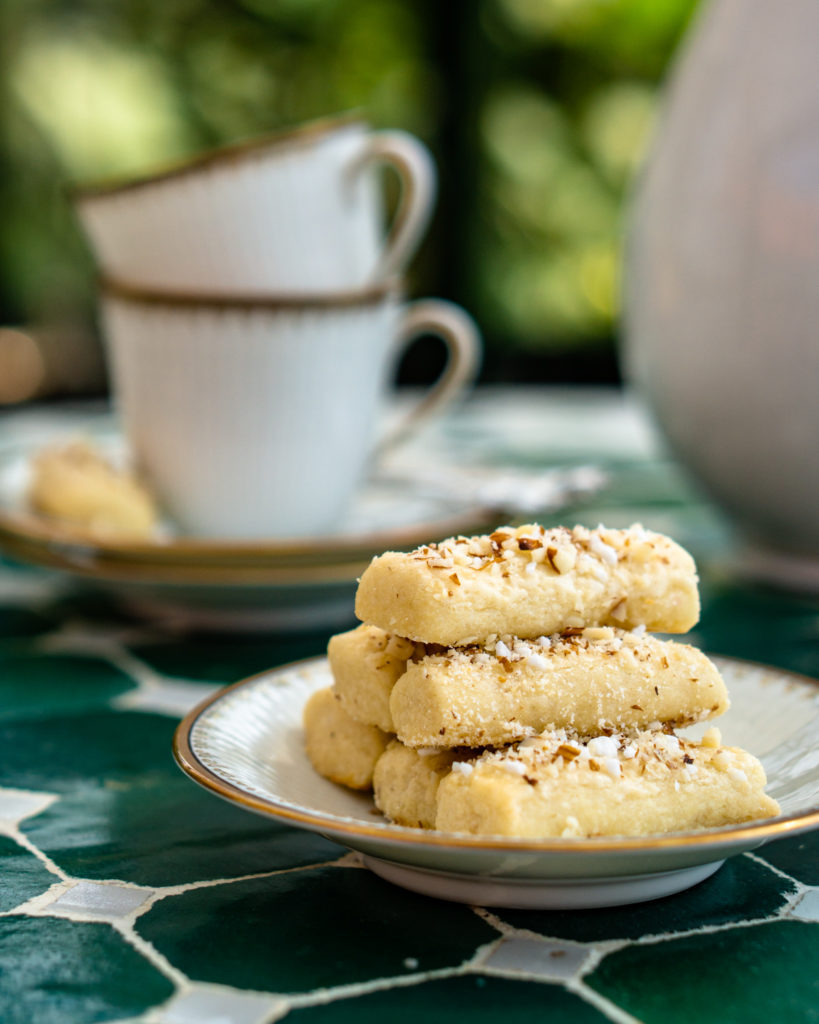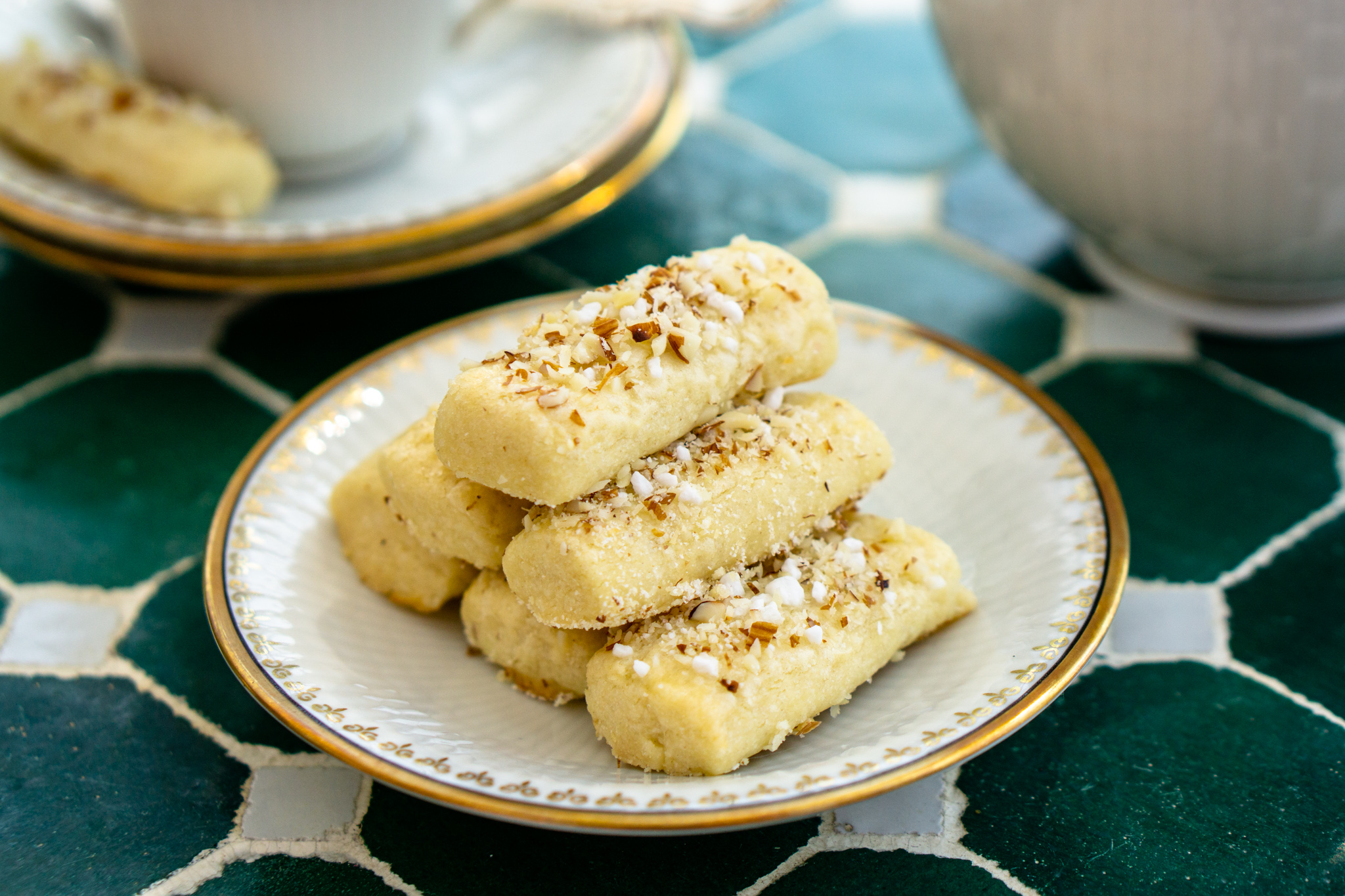Is it not weird how one small detail in a recipe can reveal so much about the time in which it was written? The thought hit me as I was sprinkling chopped almonds over the tray of the shortbread cookie Finnish sticks, or “finska pinnar”. I had to chop up a few more almonds — the amount suggested by the recipe wasn’t enough.
I’d followed the recipe from my great grandmother’s Stora Kokboken from 1948 but had mindlessly forgotten parts of the instructions. After you’ve brushed the cookies with egg white, the instruction tells you to “turn them on almond and pearl sugar.” I compared it with the recipe from Vår kokbok from 2015 who was lying beside it. “Sprinkle with chopped almond and pearl sugar.”
To do as I did and sprinkle the almonds leads to waste, and that’s why I needed more almonds. For the newer cookbook — and for me — it was not a big thing. But with the tray full of cookies with chopped almonds and pearl sugar sprinkled both over them and spilled on the side, I thought about what my great grandmother would have thought of the waste. Sure, it was only a few almonds and a little sugar that I carelessly wasted. But, I could not believe that she would have taken it lightly, she who run a boarding house during Sweden’s time of rationing.
The history of the Finnish Sticks
The origin of the Finnish sticks doesn’t have anything to do with Sweden’s neighbor Finland, according to historian Dick Harrison’s article in Svenska Dagbladet. He claims that similar cookies have existed in Southern Skåne as well as Northern Norrland, and it’s difficult to say where the cookie got its start — if it even was only one location.
Harrison also suggests that there are similar cookies in other countries but that it only is in Sweden that they are known as Finnish sticks.
My investigations turned sadly unscientific, but for quite some time I’ve asked all people I’ve met who have any connection to Finland. So far, they have all denied that the cookies would be particularly Finnish.
So, so far, the reason that made these cookies called Finnish isn’t solved. But! It looks like the Swedes have enjoyed them at least during the larger part of the 20th century:

What is a Finnish stick cookie?
Well, the name may have varied a bit, but the idea of what a cookie with Finnish connections should contain seems to be constant.
The oldest recipe I’ve found is from Hemmets kokbok from 1917, which features “finska kaffebröd”, or Finnish coffee [fika] cookies. The dough includes butter, flour, sugar and bitter almonds. The cookie is brushed with egg white and you then decorate it with almonds and pearl sugar. The dough isn’t particularly sweet — only four tablespoons of sugar to roughly a kilo of flour and butter.
In the somewhat later Husmoderns 1000 recept from 1924, we find a recipe of a similar cookie — here without bitter almonds and shaped into round cookies, called “finnkransar”, or Finnish wreaths.
The famous Prinsessornas kokbok from 1934 incudes a recipe similar to the one in Hemmets kokbok, but skip the pearl sugar. Stora kokboken from 1948 has regular “finska bröd”, literally Finnish breads, and also recommends a finer version where parts of the flour are replaced with grated almond. In my books, the cookie really benefits from the extra almond, which also helps it to stay moist.
Finnish sticks — a Christmas cookie?
I’ve never connected finska pinnar particularly with Christmas, but judging from the articles and ads in Svenska Dagbladet, there seems to be one such connection. In 1950, they appear in a December ad from supermarket Konsum, which offers gingerbread cookies, crackers, finska pinnar, and “brown cookies”.
In an ad from 1956, you’ll find a recipe for Finnish sticks, as well as saffron buns and gingerbread cookies. It was Svenska Mejeriernas Riksförening (the Swedish Dairy Association) who posted the ad which claims “a lot can be replaced — but never the taste of butter.” I am bound to agree with these fine fellows.
During the 60s and 60s, Finnish sticks appear several times in Svenska Dagbladet in connection with Christmas, for example in 1974 when Hiram lists Christmas cookies: “…mandelmusslor, rosette cookies, chocolate leaves, glass pretzels, aces and Finnish sticks, cinnamon hearts…”
Finnish sticks are also mentioned in an article with baking tips, “Baktips inför julen”, from 1983. In 1988, another article claims that finska pinnar “belongs to the classic Christmas cookies” and are “rational”, while another in 1989 suggests that they “belong to the trust-worthy Christmas cookies.”
Even if Finnish sticks appear in articles around the year, they seem to have been connected to Christmas. How did this connection happen? After reviewing the articles, my theory that it is because it is a simple shortbread cookie. It is based on an easy-to-make foundational dough that can be varied with small means. Those who wish to save time and energy during the big Christmas bake can make a large batch of shortbread dough which then can be flavored, shaped, and transformed into several different cookies. A convenient way to produce impressive Christmas cookies, both when it comes to quantity and variation!

How to make the Swedish cookie “Finnish sticks”
Finnish sticks are unfortunately known for being dry and boring. No wonder they get such a review, if you nab a sad old cake from a forgotten cookie pack in the office pantry. Butter and bitter almonds? It will rather be made with margarine and artificial flavouring! Skip those dreadful ingredients, make them according to the recipe below, and eat them fresh. Then you’ll be of a different opinion when these subtle yet delicious cookies are concerned.
Ingredients
Dough
3/4 dl (1/3 cup) almonds
3-4 bitter almonds (or a few drops of bitter almond aroma)
3 1/2 tbsp sugar
200 g (1/2 + 1/4 cup, together) butter
4 dl (1 2/3 cups) flour (possibly 1-2 tbsp more)
Brushing and decoration
1 egg white
about 3 tbsp chopped almonds
about 3 tbsp pearl sugar
Instructions
- Start by grating the dough’s almonds and bitter almonds with a nut grinder or mixer so you get a fine flour. If you’re using a mixer, ensure there are no large pieces (it won’t taste nice if those pieces are bitter almond) — but don’t run the mixer for so long that the almonds start to give off their oil and lump together.
- Place the grated almond and bitter almond in a large bowl with sugar, butter, and flour. Chop it all together with a wooden spoon or your fingers until you get a grainy dough. Stir until you can form a dough — you may need a little bit more flour.
- Set the oven to 200°C (400°F). Prepare baking trays with baking paper. Cover the dough with plastic foil and let it rest in the fridge for 30 minutes.
- Roll or press the dough into long sticks, thick as a finger. Cut pieces that are 4-5 centimeters long or 6 cm if you fancy following Storka kokboken. That would be 2 inches or slightly more or less depending on your preference. Place the “sticks” on the tray, brush them with lightly whisked egg white, and sprinkle them with chopped almonds and pearl sugar. Lightly press the toppings into the cookie.
- Bake the cookie on the middle rack of the oven for 10-12 minutes. You want them to be lightly golden but not too brown. Let them cool on the tray so they won’t be as fragile when you move them. Eat and enjoy!
Suggestions
This recipe follows the suggestions from Stora kokboken when it comes to adding extra almonds to the dough. If you don’t want to have almonds in the dough, skip them and add 1/2 dl (3 tbsp) extra flour in the dough instead.
It can be tempting to increase the amount of bitter almond with the hope to add extra flavor. Don’t do that — it contains substances that can form the poisonous hydrogen cyanide. According to Livsmedelsverket (the Swedish National Food Administration), small amounts of bitter almonds in baked goods do not cause humans any harm, but if you’re hesitant, you can use bitter almond aroma instead.
The classic version is topped with chopped almonds and pearl sugar. You can of course use both, either, or anything else you fancy to make the recipe your own.
After having tried both sprinkling and dipping the cookies in the toppings, I find that I still prefer the wasteful version. It is simply easier to get nicely shaped cookies — and you can always gather up the waste before baking and use them again.



In English consideration, I had to chuckle as I know I’m going to make these during our Frozen Time currently in Texas.
I’m certainly going to “finish” these Finnish Sticks quickly after giving some to our two neighbors.
Thanks for allowing us to share in the history and recipes. Woo Hoo!
Gregory, baking sounds like a great way to handle some unexpectedly rough weather. I hope you’ll enjoy this “extra almonds” recipe as much as I did. Stay safe.
What would the flour amount in grams be for the dough? I find cups sometimes inaccurate and am not familiar with dl.
Hi Suz, a quick conversion shows that it would be 240 g plain wheat flour.
Good to have you back, Isabelle. Missed you! Now to fika-time with Finska Pinnar!
Thank you Siri, I really appreciate your comment and support. Hope you’ll enjoy the cookies!
Hej, Thank you for this recipe. My mother used to make these at Christmas. She topped them with buttercream frosting and nutmeg, and called them nutmeg logs. I had no idea they came from her Swedish heritage. My great grandmother was first generation Swedish-American and grew up in a Swedish community in the Midwest. So my Swedish roots are close enough to know about them, but far enough away that they had very little influence in my life. These were my favorite cookies but I quit making them and lost the recipe over the years. I’m glad to have the recipe again, and very glad I found the Swedish Spoon.
Sherry, thank you for your lovely comment and for sharing your memories of your mother’s cookies.
Nutmeg logs — how wonderful! I’m sure it makes for a beautiful combination (in fact, now I got tempted to try making them).
Take a look at this Sherry.
https://www.bakepedia.com/nutmeg-logs-recipe/
I have a travel mug with Fika on it and when I see a reference it makes me happy. my email is about koffee and kuilts I should have added kookies too. thanks Vg
Hej Vickie. Yes, it sounds like koffee and kuilts definitely needs some kookies, too!